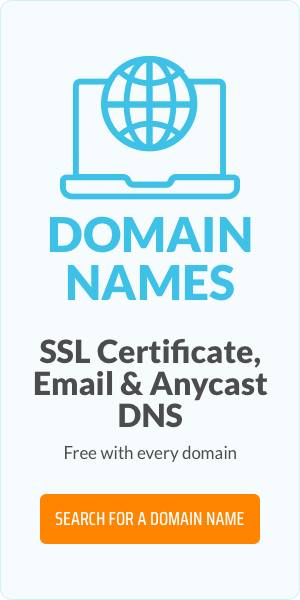Getting Your Small Business Online in 3 Easy Steps

Not sure how to launch your first small business website? We're here to help you move forward with confidence as you take your initial steps! Start with these three basics and you'll be on the right track to getting your small business website up and running stress-free!
If you're a small business owner looking to establish an online presence, you're in the right place. In this guide, we'll introduce you to three simple steps to set up your website. We'll walk you through registering your domain name, choosing the right web hosting provider, and selecting the best content management system (CMS) or website builder for your needs. Let's get started!
1. Register Your Domain Name
Choosing a domain name is one of the most important steps in establishing your online presence. Your domain name identifies who you are and what you do, and it can even specify your location if you opt for a country code top-level domain (ccTLD). Whether you choose a .COM, a new generic top-level domain, or a ccTLD, keep these tips in mind:
- Match Your Brand: Include your brand name or an industry keyword that clearly conveys your business's identity and the services or products you offer.
- Keep It Simple: Make your domain name memorable, easy to type, and easy to pronounce. Avoid special characters like hyphens and numbers, and steer clear of unusual spellings.
- Avoid Copyright Infringement: Ensure your domain name doesn't infringe on any trademarks. It's your responsibility to research and confirm this before registering your domain.
- Think Long-Term: Choose a domain name that will stand the test of time and won’t need to be changed as your business grows or evolves.
- Consider SEO: Including relevant keywords in your domain name can improve your search engine rankings and make it easier for customers to find you online
For more detailed guidance, check out this comprehensive guide on how to choose your perfect website domain name.

Protecting your domain name is crucial for safeguarding your business reputation and ensuring customer trust. Here’s how to secure your domain:
- Domain Protection: Use two-step verification and reliable DNS services. Manage your domain effectively with proper tools to prevent unauthorized access.
- Business Reputation: Avoid the risk of losing your domain by renewing it on time. Consider long-term registration to prevent accidental expiration and the complications that follow.
- Customer Security:SSL certificates are essential for encrypting data transmission on your website. This not only protects your customers' information but also enhances your site’s credibility.
- Monitor Your Domain: Regularly check your domain status and ensure your contact information is up-to-date to receive important notifications from your registrar.
2. Choose Your Web Hosting Provider
Web hosting is essential for making your website accessible online. After registering your domain name, select a web hosting provider that meets your needs. Key factors to consider include:
- Affordability:Shared hosting is a budget-friendly option, especially for small businesses. It’s a cost-effective way to get started.
- Resource Needs: Shared hosting usually offers sufficient resources for most small business websites unless you expect high traffic or extensive media usage. A monthly bandwidth of around 10 GB should be adequate for most SMBs.
- User-Friendly Control Panel: A simple control panel interface is crucial for easy website management, saving you time and effort.
- Customer Support: Ensure your hosting provider offers 24/7 customer support to help you resolve any issues quickly.
- Scalability: Choose a provider that allows you to upgrade your hosting plan as your business grows.
Security Measures
Prioritize security to protect your website and data:
- Comprehensive Security: Small business websites can be targets for cybercriminals. Choose a hosting provider with robust security features to protect against bot networks, Denial of Service (DoS) attacks, and other threats.
- SSL Setup: An SSL certificate encrypts data between your website and your visitors’ browsers, enhancing security and trustworthiness. Compare SSL certificates to find the best one for your needs.
- Backups: Ensure your hosting plan includes automatic backups. This is crucial for data recovery in case of a security breach.
- Firewall and Malware Protection: Use a firewall and malware scanning tools to protect your website from malicious attacks.
- Regular Updates: Keep your website software and plugins up-to-date to protect against security vulnerabilities.
3. Choose Your CMS
A content management system (CMS) helps you build and manage your website’s digital content. Here are some popular CMS options:
- WordPress: Powering 44% of all websites, WordPress is a popular choice for small businesses. It’s user-friendly, with numerous plugins available to customize your site.
- Joomla: Known for its strong e-commerce functionality, Joomla offers a range of templates, extensions, and security features to create a professional e-commerce website.
- Drupal: Ideal for larger, more complex websites, Drupal requires more technical knowledge but offers powerful capabilities.
- HubSpot CMS: This SaaS provides tools for content creation, distribution, and analytics, making it easy to manage blog posts, landing pages, and emails. It’s particularly strong in personalized and smart content delivery.
- Wix and Squarespace: These platforms offer user-friendly, drag-and-drop interfaces, making them ideal for small businesses without technical expertise. They also provide built-in SEO tools and mobile optimization.
Website Builder
If you prefer a simpler solution, consider using a website builder:
- Simplicity: Website builders require less time and effort than a CMS. Just drag and drop elements into place and edit your site in real time.
- Functionality: While offering fewer options than a CMS, website builders like SitePad provide the necessary themes and widgets for a small business website.
- Maintenance-Free: Modify existing pages with new features as they become available, and rely on your web hosting provider for automatic backups and security updates.
- Integrated Solutions: Many website builders offer integrated e-commerce solutions, marketing tools, and analytics to help you grow your business online.
Additional Tips for Small Businesses
- Mobile Optimization: Ensure your website is mobile-friendly as a significant portion of users access the internet via mobile devices.
- SEO Best Practices: Research and implement SEO best practices to improve your website’s visibility in search engine results.
- Content Strategy: Develop a content strategy that includes regular blog posts, social media updates, and email newsletters to engage your audience and drive traffic to your site.
- Analytics: Use tools like Google Analytics to monitor your website’s performance and gain insights into visitor behavior.
- Professional Email Address: Set up a personalized professional email address using your domain name to enhance your business’s credibility.
Launch Your Small Business Website Today!
You’re now ready to start developing your website’s design and content. Remember to research SEO and set up a personalized professional email address. By following these initial steps, you'll be well on your way to establishing a successful online presence.
What Exactly is Domain Authority and How Can it Boost your SEO?
Related articles:
